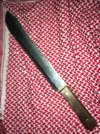- Joined
- Nov 20, 2005
- Messages
- 19,385
I have a broad selection of the Condor line of machetes; short to long. But the Puerto Rican and the wood handled El Salvador models are my favorites. The Pack Golok or Village Parang might be my choice for wacking at larger thicker wood such as I have when big limbs fall down from the trees in my back yard or along a trail. Sometimes the Condor Kumunga is my choice for trails if I want a really large blade that isn't as heavy as the Pack Golok. I seldom carry a really large knife on a trail and the Kumunga comes in handy from time to time.



